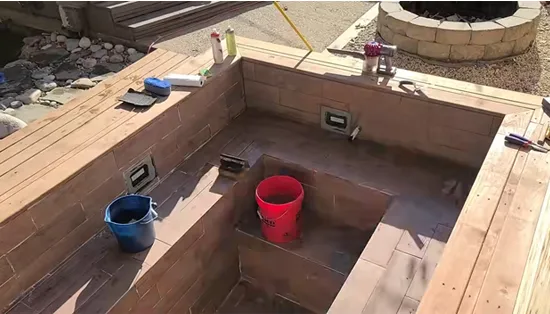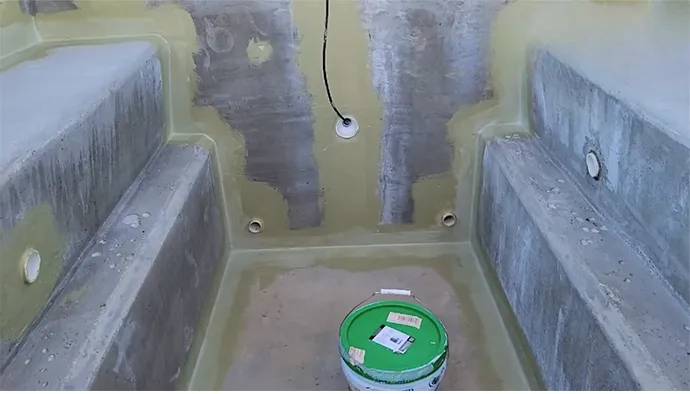Last Updated on January 20, 2023
Sealing a concrete hot tub is an important part of ensuring the longevity and durability of your hot tub. It can help to protect against water damage, mold, and mildew build-up in the hot tub’s structure. Whether you’re a homeowner or a pool service professional, knowing how to properly seal a concrete hot tub is essential.
In this blog post, we will discuss the necessary preparation steps, product specifications to consider, application process, safety measures to take and final steps needed to ensure your concrete hot tub is properly sealed.
Preparation for Sealing
Sealing a concrete hot tub requires careful preparation in order for the sealant to adhere properly and last for years. It is important to ensure that the surface is clean of debris, dirt and other imperfections before applying any sealant.
Additionally, the surrounding area must be masked off to avoid overspray and other messes. In this discussion, we will delve into each step of the preparation process in greater detail so that you can confidently prepare your concrete hot tub for sealing.
Cleaning the Surface:
Before sealing a concrete hot tub, it is essential to clean off all dirt, debris and other imperfections from its surface. This can be done with a shop vacuum or by wiping down the surface with a wet rag.
It is advisable to wear protective gloves during this process to protect your hands from coming into direct contact with any harsh chemicals or solvents used in cleaning. Once the surface has been cleaned and dried, it should be inspected carefully for cracks or other flaws which may need repairing before proceeding with sealing.
Remove Debris, Dirt and Other Debris:
The first step in preparing a concrete hot tub for sealing is removing all debris, dirt and other debris from its surface. A shop vacuum is usually sufficient for this purpose but if necessary you can use a damp cloth or sponge as well as mild detergents or solvents such as dish soap or laundry detergent.
Make sure you are wearing protective gloves when using any chemical-based cleaning products in order to avoid skin irritation or potential long-term health effects from exposure. After cleaning, allow ample time for the surface to dry completely before moving onto inspecting it closely for flaws.
Inspect For Cracks Or Imperfections:
Once the concrete hot tub has been thoroughly cleaned and dried it needs to be inspected closely for cracks or any other visible faults which may require repair prior to application of sealant. An experienced contractor should be consulted when attempting any repairs on your own as incorrect procedures could lead to further damage and an inadequate sealant job later on down the line.
A professional inspection can also provide insight into potential issues that may not have been visible previously due to improper cleaning procedures being used beforehand such as mold growth underneath layer of dirt or not identifying existing cracks until after they are filled up with cement patching material instead of being actually repaired fully at first place .
Repair Any Visible Flaws With The Cement Patch:
If there are any visible cracks or imperfections present on your concrete hot tub then these should be repaired prior to application of sealant using an appropriate cement patch material available from most hardware stores today.
The patch should be mixed according to instructions given by manufacturer before being applied over affected area by smoothing out evenly with putty knife along its full length without leaving any bumps behind on finished product afterwards .
Make sure you are wearing safety glasses and protective clothing while doing so as well avoid getting splatter onto surrounding areas elsewhere within same room itself at all costs!
Masking Off The Area:
Once all repairs have been made and dried, it’s time to mask off the surrounding area near your concrete hot tub in order avoid overspray during sealant application process itself afterwards too late already!
Masking tape shouldable securely around all walls floors fixtures furniture etc that may come into contact with sealant itself give yourself extra buffer space when possible better safe than sorry at end day here – don’t forget put down plastic sheeting underneath area where actual work going take place just incase anything does happen leak through somehow despite precautions taken aheadtime ensure easy cleanup afterwards without hassle lateron either way still though!
Applying Sealant

Applying sealant is an important part of creating a waterproof and durable concrete hot tub. It’s also an essential step in reinforcing the structure of the tub. In order to get the best results, it’s important to select a product that is appropriate for the type of concrete used in the project and to follow safety instructions carefully. This guide will provide an in-depth discussion on how to apply sealant correctly.
Selecting a Product
It’s important to select a sealant that is specifically designed for use with concrete hot tubs. Some sealants are formulated for different types of surfaces, such as wood or metal, so be sure to read the label carefully before making a purchase.
The product should also be water-resistant and have good weather resistance properties. Additionally, make sure that there is no risk of staining or discoloration if it comes into contact with other materials like paint or fabrics.
Determining Whether Primer Is Needed:
Most sealants require some kind of primer before application in order to ensure optimal performance and protection from water damage and wear over time. Before applying any kind of sealant, it’s important to determine whether or not a primer is necessary by reading the instructions on the container.
If one is required, make sure it has been applied thoroughly and allowed ample time to dry before moving on to sealing the surface with additional coats of sealant.
Safety Measures & Precautions:
As with any project involving chemicals or material application, there are certain safety measures that should be taken when applying sealant on concrete hot tub surfaces. Wear protective clothing such as gloves and eye protection while handling any kind of chemical-based product, especially those containing solvents or volatile organic compounds (VOCs).
Make sure that all areas being worked in are well-ventilated; wear an appropriate dust mask if needed as some products can create dust when stirred or mixed together prior to application. Finally, keep children and pets away from the area where you are working for their own safety purposes.
Application Process:
Once all safety protocols have been followed and all materials have been gathered, you can begin applying your chosen sealant product following these steps:
• Stir the sealant completely before use;
• Apply evenly using a brush or roller;
• Allow each coat of sealant to dry completely before adding additional coats;
• Touch up any missed spots once all coats have been applied;
• Allow entire surface area ample time to cure properly after completion of application process.
Final Steps:
Once you have completed applying your sealant according to directions given on container, allow ample time for it to fully cure before using your hot tub once again. Usually 48 hours depending on brand/type used.
Then inspect your work periodically throughout its lifetime looking for signs of wear or breaking down due to age/sun exposure/chemical damage etc., which can occur over time without proper maintenance procedures being implemented regularly on sealed surfaces like these ones created around concrete hot tubs!
What type of sealant should be used to effectively waterproof a concrete hot tub?

When it comes to sealing a concrete hot tub, the type of sealant used can play a critical role in waterproofing the structure. The best type of sealant to use is one that is specifically designed for use with concrete and masonry surfaces, such as an acrylic or polyurethane-based sealer.
Acrylic sealers are a great choice for sealing concrete hot tubs because they penetrate deeply into the surface, forming a strong bond that will effectively waterproof the area. Polyurethane-based sealers are also an excellent option for protecting concrete hot tubs, as they will provide superior protection against water seepage and chemical attack.
Is it necessary to apply a primer before sealing a concrete hot tub, and if so, what type should be used?
It is essential to apply a primer before applying any type of sealant on your concrete hot tub. Primers work by providing a layer between the substrate and the sealant, creating a stronger bond between them to ensure maximum protection against water penetration or staining from harsh chemicals.
The best kind of primer to use when sealing a concrete hot tub is an epoxy-based primer, as it offers superior adhesion and provides protection against both water and chemical damage.
Is it important to wait for the concrete hot tub to cure completely before applying the sealant?
When sealing your concrete hot tub, it is essential to allow sufficient time for the structure to cure completely before applying any kind of sealant or coating.
The curing process helps ensure that all moisture has been removed from the substrate which allows the primer and sealant to adhere properly once applied. If you attempt to apply any kind of coating or finish before allowing your hot tub to cure completely, you could end up with permanent staining or bubbling along the surface due to trapped moisture in the substrate.
Should you use an acrylic or polyurethane based sealer when sealing a concrete hot tub?
When choosing which type of sealer should be used on your concrete hot tub, it’s important to note that both acrylic and polyurethane-based options are available. Both types of seals are effective in their own unique ways; however acrylic sealers tend to be slightly more flexible than polyurethane-based ones while still maintaining superior waterproofing capabilities.
In addition, acrylics don’t require an additional top coat whereas polyurethanes do need one in order to achieve maximum protection against water seepage or chemical attack over time. For this reason, many people opt for acrylics when sealing their concrete hot tubs since they offer excellent waterproofing capabilities without needing any extra steps or additional products during application.
Conclusion
Sealing concrete hot tubs is essential to ensure they maintain their structural integrity and stay protected from water damage and mold buildup. While there are several steps involved in prepping for the job and applying sealant, following these instructions can help you complete the project safely and successfully.
To get started on sealing your concrete hot tub, make sure that you clean the surface thoroughly before masking off the area where you plan on applying the sealant, check for any product specifications that need fulfilling and keeping safety measures in mind throughout the entire application process. Lastly, be sure to give the sealant enough time to set before using your newly sealed concrete hot tub!



